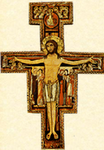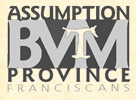Christmas Countdown, Part 3
 Yesterday’s Advent "O” Antiphon was “O Root of Jesse” and today’s is “O Key of David”. As you can see, these are Old Testament designations of the Messiah, the Anointed of God.
Yesterday’s Advent "O” Antiphon was “O Root of Jesse” and today’s is “O Key of David”. As you can see, these are Old Testament designations of the Messiah, the Anointed of God.
From early times the Christian community has understood Jesus of Nazareth to be the Christ (Messiah) and Lord whom God sent for our salvation (see Acts 2:36).
Over and over again in the Gospels, especially Matthew and Luke, we have references to the prophets of Israel being fulfilled in the person, life, ministry and paschal mystery of Jesus Christ.
We profess in the Nicene Creed every Sunday and Holy Day of Obligation, “We believe in one Lord, Jesus Christ, the only Son of God . . . On the third day he arose again in fulfillment of the Scriptures . . .”
Today’s Gospel, though, focuses on Mary’s call – her vocation – to be the Theotokos (the one who bears God, from the Third Ecumenical Council, at Ephesus in AD 431). This is her unique role, her unique ministry in the history of the human race. No one before or since has been called to be Theotokos!
The First Reading today is from Isaiah 7:10-14, in which the Prophet is instructed by the LORD to speak to King Ahaz of Judea to seek a sign from the Most High. The king balks, and the LORD reprimands him. He then provides a sign – a young woman (in Greek, virgin) will conceive and give birth to a son, who shall be named Immanuel (God is with us; literally, “with us is God” in Hebrew).
An ancient Christian icon of Mary as Mother of God (Theotokos) is Our Lady of the Sign, in which Immanuel is shown in her womb.
 Greek Icon of Our Lady of the Sign
Greek Icon of Our Lady of the Sign
St. Francis of Assisi called upon all believers to practice penance and produce worthy fruits of penance; that is, to live holy lives in accordance with the Scriptures and the very life of the Lord Jesus Christ. He teaches us Franciscan friars, all members of the Franciscan family (religious and lay people alike),
“Oh, how happy and blessed are these men and women when the Spirit of the Lord will rest upon them (cf. Isa. 11:2) and He will make His home and dwelling among them (cf. Jn. 14:23). They are children of the heavenly Father (cf. Mat 5:45) whose works they do, and they are spouses, brothers, sisters, and mother of our Lord Jesus Christ (cf. Mat 12:40) . . . [We are] mothers when we carry Him in our heart and body (cf. 1 Cor. 6:20) through divine love and pure and sincere conscience and [when] we give birth to Him through [His] holy manner of working, which should shine before others as an example (cf. Mat. 5:16).” (First Version of the Letter to the Faithful, 5-7, 10)
Such is the Christian vocation and the Franciscan vocation. In our Assumption BVM Province, way back in 1987 (20 years ago!), we drew up a Mission Statement, part of which reads, “Our mission in the Church is to make visible the presence of Christ in the world.”
 Bro. Andrew Brophy, OFM, serving God's People at St. Francis of Assisi Parish, Greenwood, MS
Bro. Andrew Brophy, OFM, serving God's People at St. Francis of Assisi Parish, Greenwood, MS
While Mary’s vocation as Theotokos was certainly singular, we are no less called by God through our Savior Jesus Christ to “bear God” in our world. And we make him visible through holy lives, as St. Francis exhorted and St. Clare of Assisi affirmed.
What are some ways that God is calling you (and me!) to “give birth” to Jesus Christ realistically in our world today? What are the penances and the fruits of penance in which the presence of the Lord Jesus is made visible in and through our lives?
O Root of Jesse, you stand for ensign of humankind; before you rulers shall keep silence, and to you all nations have recourse. Come, save us, and do not delay!
O Key of David and Scepter of the House of Israel: you open and no one closes; you close an no one opens. Come, and deliver from the chains of prison those who sit in darkness and in the shadow of death!



